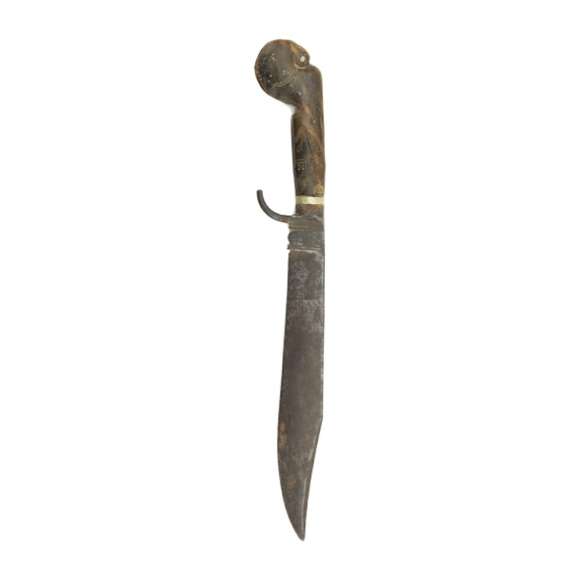With carved horn hilt and characteristic finger guard.

27.7 cm
11.5 cm
Base 6 mm
223 grams
Iron, yellow metal (probably gold amalgam), gold-copper alloy (probably suassa), silver,
black coral (Antipathes orichalcea), non-CITES listed, horn
Kandy, Kingdom of Kandy
Sri Lanka
Circa 1750-1800
European private collection
Introduction
Often called piha-kaetta, which are actually the chopper versions, these knives were mainly made by the King's Workshops in Kandy called Paṭṭal Hatara or "Four Workshops":
"The best of the higher craftsmen (gold and silversmiths, painters and ivory carvers, etc.) working immediately for the King formed a close, largely hereditary, corporation of craftsmen called the Paṭṭal-Hatara (Four Workshops); These men worked only for the King, unless by his express permission (though, of course, their sons or pupils might do otherwise); they were liable to be continually engaged in Kandy..."
-Ananda Coomaraswamy, 1908
Silver-mounted pihiya were presented to Adigar (minister-governors) when promoted to their positions. Others were made as diplomatic gifts.
In making these, or any art for that matter, the Sinhalese craftsman was not interested in expressing his own person; he was attempting to express his culture in the best possible way. Competition between makers was thus not in coming up with more creative designs but instead focused on ever finer execution of their traditional patterns. The height of this work was reached in the 18th century, and by 1815, production was seized when the kingdom fell to the British.
This example
An unusual pihiya in terms of materials used. It has the classic form of these, but the hilt fittings and blade plating that are normally silver are a gold-coper alloy. The material looks very similar to Indonesian suassa. So similar that I suspect it might be exactly that, possibly imported into Sri Lanka by the Dutch VOC, who controlled coastal Sri Lanka and had trading posts in Galle, Jaffna, and Colombo. This material may have been used to bypass Royal regulations that pure gold was only meant for the king of Kandy himself. The grip itself is also unusual in that each scale is made of brown horn, with a wide strip of black coral inlaid in the center.
Condition
Very good condition throughout. One small missing ornament on the left side of the grip, and a small pin missing on the right side. Otherwise the condition is about as good as these get. No scabbard.









Of nice quality, with unusual openwork silver bolster with serapendiya.
Canton work for the Japanese market, with 28 metal balls in separate compartments.






